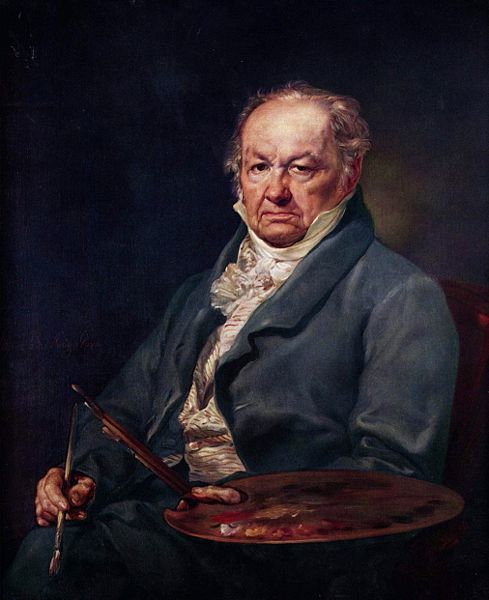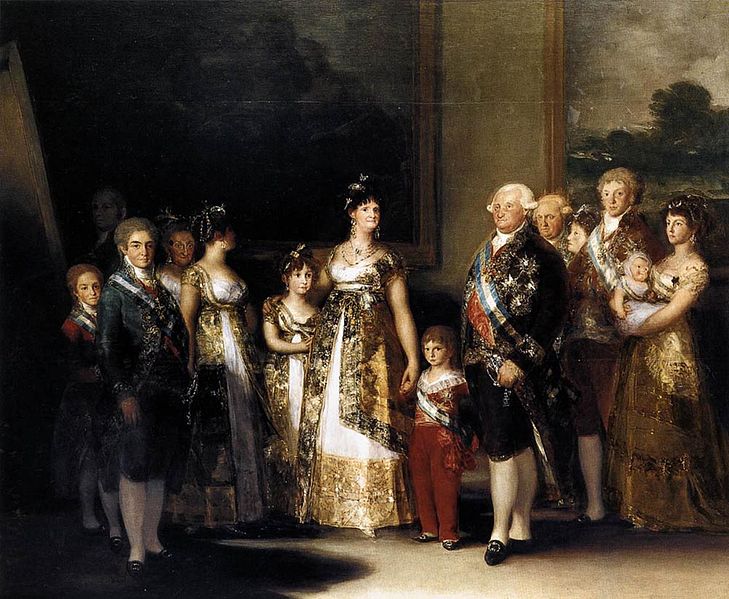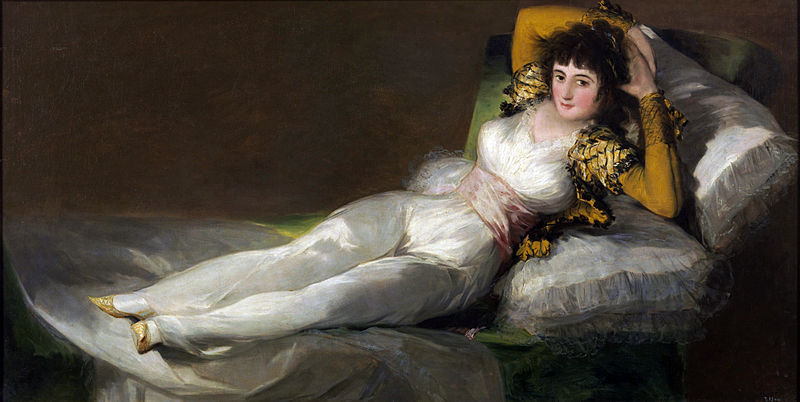| Francisco de Goya | |
|---|---|
 |
|
| Born | Mar. 30, 1746 Fuendetodos, Aragón, Spain |
| Died | Apr. 16, 1828 (at age 82) Bordeaux, France |
| Nationality | Spanish |
| Movement | Romanticism |
| Field | Painting, Printmaking |
Goya was a unique painter. He was known for his dark prints, and paintings, and for being cruelly realistic in each one of them. He never tried to beautify a personal portrait, and he portrayed things as he saw them, not how people wanted them. Goya was only famous with the aristocrats when he was alive, which is more than most artists can say.
Francisco de Goya was born in Aragón, Spain, on March 30, 1746. His dad was a guilder, and his family was middle class. They lived in a house that bore his mom’s family crest, but later moved to Madrid. At the age of 14, he became an apprentice to José Luzán, but was not with him for long because of the move to Madrid.
At Madrid, he studied with Anton Raphael Mengs, and spent a few years working with him. He failed his examinations with Mengs, and applied to the Royal Academy of Art in 1763, but was denied on the basis of not having enough experience. He applied again in 1766, but was rejected again for the same reason.
Goya painted his first project in the late 1760’s at the Basilica of the Pillar in Zaragota, Spain. He was living there at the time, and they just needed a few artists to help finish the job they had been working on for some time.
 On July 25, 1773, Francisco married Josefa. She was a niece to one of the administrators at the Royal Academy of Art, and Goya reapplied shortly after their honeymoon, and was accepted. In 1775, he went to work for the Royal Tapestry Workshop. The tapestries he designed became some of the best in the business, and he started getting personal commissions.
On July 25, 1773, Francisco married Josefa. She was a niece to one of the administrators at the Royal Academy of Art, and Goya reapplied shortly after their honeymoon, and was accepted. In 1775, he went to work for the Royal Tapestry Workshop. The tapestries he designed became some of the best in the business, and he started getting personal commissions.
In 1783, Goya had his first big break. He was to paint a portrait of Count Floridablanca, which was notably received by the aristocrats. He received more portraits, and in 1786, at the age of 40, he was appointed painter to King Charles III, then became court painter for King Charles IV in 1789.
 During 1792, Francisco contracted cholera, which left him deaf. He became a hermit to the public, only fulfilling his duty as court painter. He began etching during this time, and printed his Caprichos series. The most famous one is The Sleep of Reason Produces Monsters. It’s an etching of a boy with his face in his arms, and a giant winged monster flying behind him. All the etchings had this dark, eerie feeling to them because of the technique he used called “aquatint,” which leaves the finished prints with an overall faded look that highlights some aspects of the print, and leaves other aspects ambiguous. After they were released, Francisco and Josefa moved to a new house called the Deaf House, which had been named by a previous owner, but the name fit him.
During 1792, Francisco contracted cholera, which left him deaf. He became a hermit to the public, only fulfilling his duty as court painter. He began etching during this time, and printed his Caprichos series. The most famous one is The Sleep of Reason Produces Monsters. It’s an etching of a boy with his face in his arms, and a giant winged monster flying behind him. All the etchings had this dark, eerie feeling to them because of the technique he used called “aquatint,” which leaves the finished prints with an overall faded look that highlights some aspects of the print, and leaves other aspects ambiguous. After they were released, Francisco and Josefa moved to a new house called the Deaf House, which had been named by a previous owner, but the name fit him.
His goal was achieved in 1799, when he was given the position of first court painter. He received a salary of 50,000 reales, and 500 ducats. The next year, he painted one of his most famous paintings, Charles IV of Spain and His Family. The picture is of the Royal family, but they are ugly. The Grandmother in the back is shown with her huge birth mark, which obscures most of her face. Charles IV is painted as the beefy man he was, and his wife looks like a toad with black hair. For being remarkably blunt in this painting, Goya still held onto his position.
 In 1814, he painted his most famous painting, The Third of May 1808. In it, soldiers are shooting innocent people, all men with the town’s Catholic Church behind them. This is based off a true event, when Napoleon had his soldiers come to Spain, and kill townsfolk, to try and force them to let him rule. Napoleon failed in the end, and this piece commemorates the Spanish revolt to him and the innocent that were killed. Also at this time, Goya moved in with his house keeper, Doña Lescadia, which was considered scandalous. She had her illegitimate daughter living with her, and it was rumored that Goya was her father.
In 1814, he painted his most famous painting, The Third of May 1808. In it, soldiers are shooting innocent people, all men with the town’s Catholic Church behind them. This is based off a true event, when Napoleon had his soldiers come to Spain, and kill townsfolk, to try and force them to let him rule. Napoleon failed in the end, and this piece commemorates the Spanish revolt to him and the innocent that were killed. Also at this time, Goya moved in with his house keeper, Doña Lescadia, which was considered scandalous. She had her illegitimate daughter living with her, and it was rumored that Goya was her father.
Shortly after, Goya started what he called the “Black paintings.” His most famous, Saturn Devouring One of his Children, is painted on his living room walls. During this period, he had become obsessed with Mythology and other stories, and painted them in a gory, macabre manner that frightened most people. He moved to Paris in 1824, to try to get away from Spain, but returned in 1826. He fell ill, and moved to Bordeaux, France, where he died in 1828, at the age of 82.